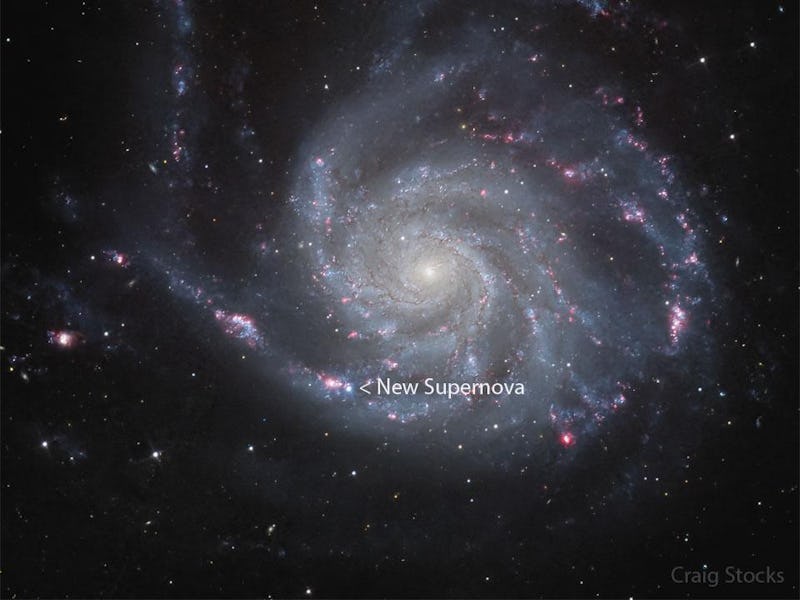A Nearby Supernova Could Be Our Chance to Hear From Aliens
Staring at giant explosions brings everyone together.

In the wake of a bright supernova in a nearby galaxy, astronomers are scanning the skies to see if anyone out there is saying, “Hey, did you see that?”
Astronomers spotted the stellar explosion in the Pinwheel Galaxy last month, and within a week, University of Washington SETI (Search for Extraterrestrial Intelligence) researcher James Davenport and his colleagues were searching stars within a few hundred light years of Earth for radio signals from alien civilizations who might have seen the same thing, New Scientist reports.
The idea is pretty simple: just as a car crash or a building fire in a neighborhood causes people to look out their windows, or maybe even wander outside and start talking, a supernova should draw attention from astronomers in dozens of star systems (assuming they’re out there). And, as University of California, Berkeley, SETI researcher Barbara Cabrales proposed earlier this year, opportunistic aliens could take advantage of the moment — and the audience — to send a signal to the other cosmic rubberneckers.
Let’s Talk to the Neighbors
We could do the same thing, Cabrales argued in January.
“If a supernova were to go off right now, I say we send a signal. Maybe someone will see it,” she told media at the time. Four months later, on May 19, a star 21 million light years away in a spiral arm of the Pinwheel Galaxy exploded dramatically. Astronomers have dubbed the event SN 2023ixf.
There’s no word yet on whether any SETI researchers here on Earth plan to broadcast a “Hey, did anyone see that big explosion?” message to nearby stars, but maybe it couldn’t hurt.
Astronomers here on Earth spotted SN 2023ixf in mid-May 2023.
Meanwhile, Davenport and his colleagues are looking for similar messages from our cosmic neighbors, if we have any. The astronomers are using radio telescopes to search about 100 stars, all within 300 light years of Earth, for radio signals.
“There are no signals yet,” Davenport tells the press, but the team plans to keep searching for several more months.
Slow-Motion Connections
The trick, of course, is that interstellar communication isn’t quick. Imagine there’s a three-car pileup on your street; you look out your window and see it, then yell downstairs to your neighbor, telling them to go take a look. All of that can happen within a matter of seconds.
But the space version takes a lot longer. Let’s say a star 21 million light years away explodes; it takes 21 million years for the light to reach you so that you can see the explosion. You send a radio message to your interstellar neighbor about 100 light years away, but that message will take 100 years to reach them.
Meanwhile, you’ve got to consider how far from the supernova your interstellar neighbor lives. Will the light from the explosion have reached them by the time they can hear your radio message?
As an example, Cabrales suggested that 32 star systems should already have seen the bright afterglow of SN 1987A, a supernova in our own Milky Way galaxy that lit up Earth’s skies in (you guessed it) 1987. If there’s anyone manning radio telescopes and transmitters on a planet around any of those stars, they’d have had time to see it and send a signal, and that signal would have had time to reach us here on Earth.
It may be a while before we can compare notes with other witnesses to the latest supernova in the Pinwheel Galaxy, in other words. But it’s worth trying.